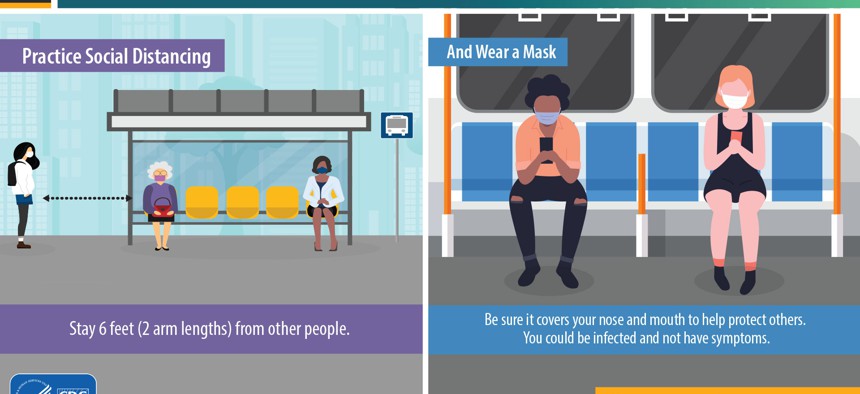
CDC
COVID and U.S. Culture -- With Lessons for Government Officials
Steve Kelman suggests that agencies need to put more emphasis on nudges.
The New York Times recently published a set of very depressing statistics. Among a group of large, high-income countries, the U.S. had the very lowest percentage of the population that is fully vaccinated against the COVID virus. The figures for the percentage who had received a booster were even more dramatic -- we had less than half the percentages vaccinated in Britain and Germany. Most distressing of all, we also had the largest cumulative per capita death rate of any of these countries -- well over double the death rate in Canada. People who are not vaccinated endanger not only themselves but other people whom they infect, meaning that this is not just a case of people lying in the bed they’ve made but of people whose behavior create dangers for others.
To me the basic reason for these differences is clear. One of the features of American culture we admire most -- our devotion to the freedom of individuals to decide what to do -- creates problems when the social interest requires us to restrict our freedom of choice, by wearing masks or being required to be vaccinated.
The polar opposite from our culture is Chinese Confucian culture, which strongly values deference to authority. The Chinese have put up with covid lockdowns and restrictions that are very draconian by our standards – cities or neighborhoods where people have not been allowed to leave their houses (the local government has delivered food to people’s homes). After initial problems as the first place COVID appeared, Chinese covid cases are now down to tiny numbers, and there have been no deaths at all for a while, quite an amazing achievement that any fair-minded person should acknowledge. (Some readers will allege these Chinese official figures are phony. Surely the Chinese government frequently covers up unpleasant information, but the government is reporting cases when they break out – why not hide these too if they are reporting phony numbers – and it is simply implausible to believe that a large number of deaths would have been unnoticed in China; there are Westerners who monitor Chinese social media carefully, and they notice social media posts the government deletes.)
Opposition to covid restrictions and mandates exists of course outside the U.S.; there have been anti-vaccine mandate demonstrations in Europe, and just now a big anti-vaccine protest among truck drivers is occurring north of us in Canada. But opposition to covid mandates has become an ongoing, central feature in our politics for months -- if you (as I do) watch Fox news in the mornings, you would think this is the most important issue facing the country.
More resistant to being told what to do, Americans are less willing to get vaccinated and boosted. Less vaccinated, they are dying more.
I bring this up not just because of what it says about covid but also for what lessons it suggests more broadly for government officials about how we can get Americans to do things that are in the social interest but that restrict individual freedom. Given American culture, forcing people to do something will likely bring about major resentment and pushback, and mean that the steps are never undertaken in the first place or that they get withdrawn.
I think the approach we need to take whenever possible involves a word invented by Richard Thaler and Cass Sunstein in a widely discussed book a number of years ago. We need to nudge people to do the right things.
The key idea behind nudging is that, rather than requiring certain behaviors, we structure the choices people face in a way that makes it easier for them to choose the socially desirable behavior. The choice is not mandated, but steps are taken that encourage it. A classic example in the nudge literature involves a person’s choice about whether to contribute to a retirement plan. Note that people need to make some choice, either to participate or not; there is no way to avoid choice altogether. The question then becomes what the default choice is. You can tell the employee that they must sign up for the retirement plan or they won’t participate. Or you can tell them the opposite, that they will be signed up unless they opt not to participate. We know that these two ways of giving people a choice produce dramatic differences in the percentage of people who join a retirement plan.
Nudges can involve making certain choices harder or easier based on how they are designed. If you put fewer elevators in a building, taking an elevator becomes harder, and more people will walk the stairs. If you make salad the default side dish rather than chips, more people will choose salad. You can also nudge people by providing certain information, such as calorie counts for different menu items.
Another nudge is to share the fact that the desired activity is done by a lot of people, using the power of social norms to influence behavior. A fascinating study a number of years ago showed that when a sign was put up in a national park that said that many people were littering and how horrible that was, littering actually increased because it suggested that “everyone is doing it.” A sign that said very few littered reduced littering.
For mask wearing, the nudge approach suggests making masks readily available in public spaces and featuring public service ads by ordinary people, or celebrities, wearing a mask, rather than mandates. I suspect that officials involved in promoting program implementation in their area can pretty easily come up with examples of how we can encourage good behavior without contradicting the importance of free choice in our culture by mandating it. Officials should think this way rather than taking the easy way out of forcing desirable behavior on people.






